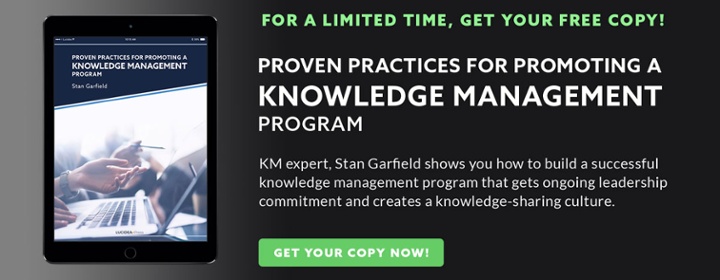
Even in a world of digital communication channels, it’s critical to hold annual enterprise-wide (or worldwide, if you work for a multinational organization) face-to-face meetings in order to get and keep all KM leaders informed, energized, and collaborating.
Once your KM community is formed and has met by phone a few times, ask for input on when, where, and for how long to have the first face-to-face meeting. Try to include as many of the key KM leaders as possible, but limit the total attendance to no more than 50 to keep the meeting manageable.
If possible, try to rotate the meeting location between different parts of the country or world. To take advantage of the meeting location, invite mostly KM leaders who will incur low travel expenses to attend. For example, when meeting in Europe, invite the KM leaders from all of the European countries, but only a few key leaders from other regions.
How to hold successful face-to-face meetings
Ask the participants to help review and approve the agenda, using your organization’s enterprise social network (ESN). This will give them some ownership of the meeting and ensure that it meets their needs.
Test each agenda item: could this be just done just as well on a call or webinar? If so, don’t include it in the meeting. Make each agenda item include interaction, specific planning, decision-making, and/or action.
Enterprise Social Networks
Use your ESN before, during, and after the meeting. As the agenda for the meeting is being developed, solicit ideas for the meeting, ask what the attendees hope to get out of the meeting, find out who they want to hear from, and what they want to hear about.
Before the meeting, ask attendees to introduce themselves virtually. They should provide their locations, organizations, roles, and specialties, interesting details about themselves, and links to their personal profiles. Initiate discussions to be continued at the meeting, polls on key topics, and leadership Q&A.
During the meeting, request live posts. Participants can ask questions and request assistance, take notes to share with people who are not there but would like to follow along, and provide feedback to the leaders of the meeting in real time. Display a live stream of posts during the meeting on a large screen.
After the meeting, report back to attendees on highlights and outcomes. Let them know what the leaders learned from the meeting, including what worked and what didn’t. And communicate all commitments, actions, and dates from the meeting.
Activities
Schedule time during the meeting for special activities. Allow attendees to meet one-on-one or in small groups with other attendees.
Enable birds-of-a-feather sessions at breakfast, lunch, and dinner to allow those with shared interests to meet, talk, and possibly form communities. Provide an innovation challenge in which attendees find others with complementary backgrounds to work together and produce a deliverable by the end of the meeting.
Education
Allow attendees to get personal instruction on useful methods, techniques, and tools. Have booths like those at a trade show, and let attendees move freely from booth to booth. Have KM tools experts available for demos, hands-on training, and Q&A. Give out points for mastering the content at each booth, and recognize those with the most points at the end.
If you invite outside guest speakers to present at the meeting, involve them in workshops following their talks. Allow participants to discuss the presentation, talk about how to implement the ideas, and commit to specific actions and follow-up checkpoints.
Provide the opportunity to discuss and exchange books. Send out a relevant book to all attendees before the meeting and hold a “book club” discussion at the meeting. Conduct a book exchange where people can bring other relevant books to swap.
Unconference or BarCamp
Include an attendee-driven segment in the agenda, also known as an unconference or BarCamp. This gives attendees a role in leading sessions, voting on which ones they prefer, and providing smaller, more interactive breakouts.
Attendees can suggest topics and offer to lead sessions. They vote on which sessions they want to attend. Based on the response, you can hold one session, several sequential sessions, or multiple parallel sessions.
An unconference is a loosely structured conference emphasizing the informal exchange of information and ideas between participants, rather than following a conventionally structured program of events. This results in descriptions such as “at this unconference, attendees created sessions on the spot, making for an energizing and freewheeling exchange.”
A BarCamp is an ad-hoc gathering born from the desire for people to share and learn in an open environment. It is an intense event with discussions, demos, and interaction from attendees.
If you are holding an organizational meeting, use a BarCamp to take advantage of the entire team being together, including (but not limited to) discussing or resolving a problem, issue, or important topic; conducting or attending training; or organizing or creating something new.
A BarCamp is similar to a knowledge café (a one-hour conversation/training among a small group of people on a work-related topic, with a specific objective or outcome), with a few key differences. BarCamps can originate with the attendees, not necessarily the organizers. They can be organized in advance, or can spring from ideas at the meeting itself. Anyone can lead a BarCamp; it does not need to be manager-led. Attendees can vote on BarCamps they want to attend.
The format is up to the leaders of each session. A common format is to state the topic and objectives, give the background and context, present the questions you’d like feedback on, and work toward some kind of demonstrable/practical conclusion.
After the meeting
Solicit feedback after the meeting. Conduct a post-meeting survey and start a thread in your ESN to allow everyone to see each other’s comments and to build on them.
Conduct a post-meeting review, including what went well, what didn’t, and the feedback provided in the survey and ESN discussion. Then act on the lessons learned and feedback received when planning the next face-to-face meeting.
If you’d like to read more on this topic, please consider my latest book, published by Lucidea Press, Proven Practices for Promoting a Knowledge Management Program, which offers a broad range of advice and insights drawn from my career as a KM practitioner.



